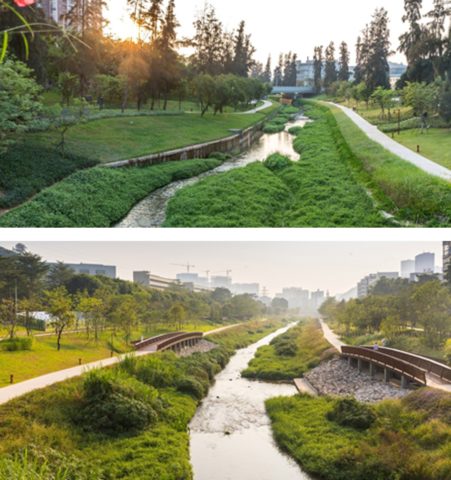

Developer: China Resources Land Co., Ltd
Designer: AECOM
Location: Nanshan District, Shenzhen, Guangdong Province, China
By Colin Galloway
Thirty years of rapid economic development in China has led to big improvements in overall living conditions, but has come also at a steep ecological cost, especially in terms of badly polluted inland waterways. In recent years, however, both local and central authorities in China have rolled out policies to regenerate contaminated watercourses, especially in densely populated urban areas. The Dasha River Ecological Corridor is a prime example of how even severely-polluted environments can be successfully rejuvenated.
Winding for 13.7 kilometres through the Nansha district of Shenzhen, starting from the University district and flowing to the river’s exit in Shenzhen Bay, the corridor is a major initiative that has created almost 100 hectares of new riverside park, forming a greenbelt traversing the western part of the city.
Though still less than ideal, the river’s water quality has now been improved. The real value of the corridor, however, lies in the quality of the associated parkland, which is divided into a series of three themed landscape zones varying in character according to the areas through which the river runs. The landscape changes as it moves through different urban areas, allowing visitors to track their location as they traverse the length of the watercourse. A network of footpaths and bicycle paths runs continuously along the river on both sides, while intermittent footbridges connect both sides of the river.

Authorities were able to create a continuous green belt along each riverbank by removing illegal buildings and bridges and connecting un-owned or idle stretches of land or green space. Indigenous animals and vegetation have been reintroduced, while invasive species were removed. Designers also preserved existing forest and wetland areas to attract more wildlife and fauna and dredged the riverbed in some areas to create new water habitats. Finally, authorities have integrated rainwater management elements to improve absorption, storage, and water purification by (among other things) introducing plant species that can naturally perform these functions, in particular by filtering out pollutants.
One of the most striking aspects of the project is how quickly it was completed. Although initial planning and site inspection work did not take place until mid-2017, the scheme was completed in stages from September 2019 through March 2020 – a timeline one juror described as: ‘Unbelievably impressive – I cannot think of anywhere else in the world where this big a project could be taken on so quickly and comprehensively.”
While the compressed timeline is one project feature that perhaps would only be possible in China, the financing needed to undertake an initiative of this size is another aspect that would be difficult to arrange in countries lacking China’s command economy. Nonetheless, the fact that it could be completed at all given the extent of the environmental damage inflicted on the river over several decades of rapid industrialisation is enormously impressive. As such, the corridor serves as a showcase of ecological regeneration that would be instructive to many cities elsewhere in the world.



Don’t have an account? Sign up for a ULI guest account.